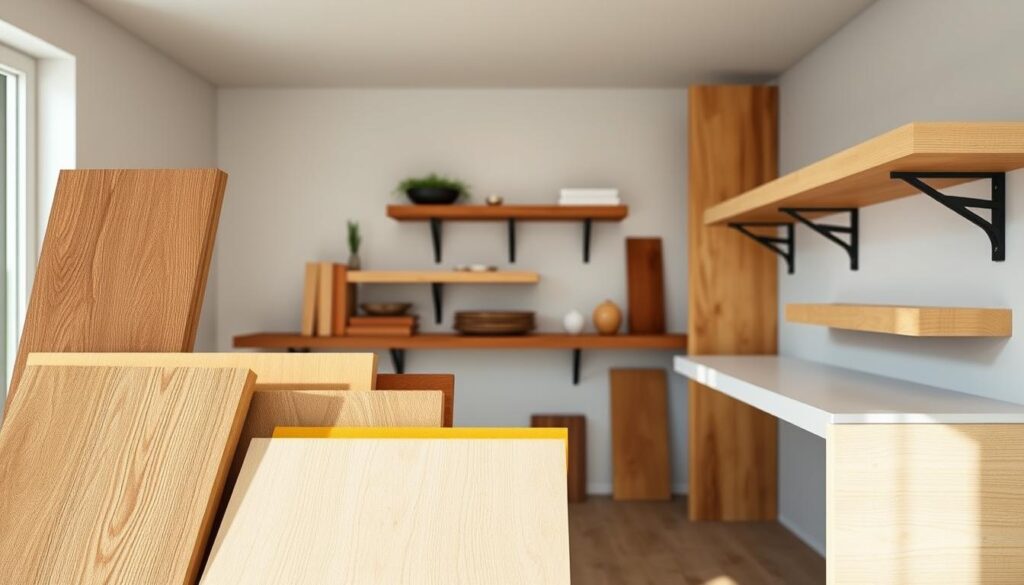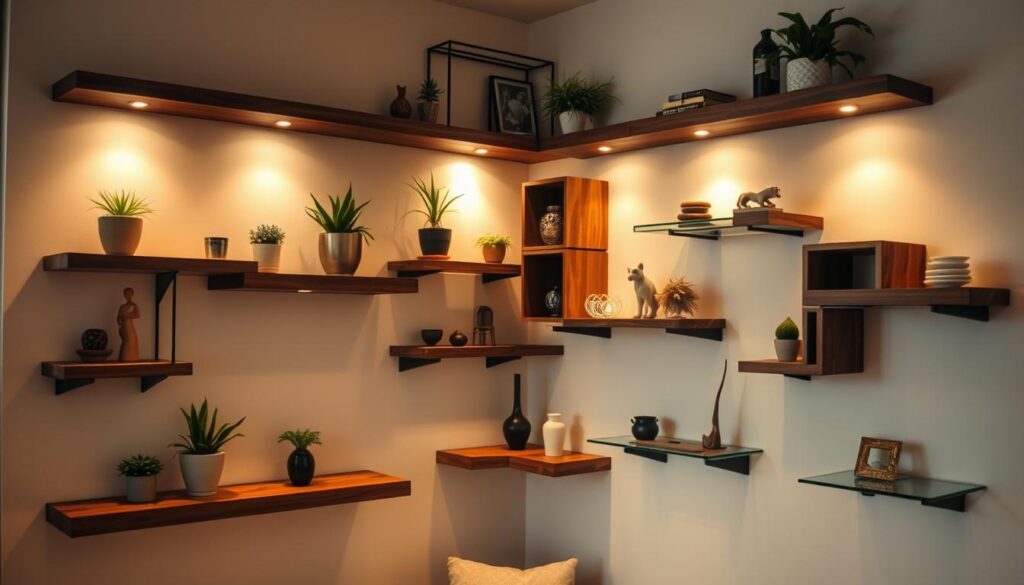Looking to upgrade your home with stylish storage that blends form and function? Modern floating shelves offer a sleek, minimalist solution for any room. These versatile additions maximize wall space while keeping your decor clutter-free. Best of all, they’re surprisingly simple to install—even for first-time DIYers!
Unlike traditional shelving, this design hides brackets completely, creating a clean “floating” effect. Whether you’re displaying plants in the living room or organizing spices in the kitchen, these shelves adapt to your needs. They work equally well in small apartments and spacious houses, proving that smart storage doesn’t require bulky furniture.
Our guide walks you through every step: planning layouts, choosing materials like wood or metal, and securing shelves properly. You’ll also discover creative styling tips to match your interior aesthetic. Ready to transform blank walls into functional art? Let’s dive in!
Key Takeaways
- Modern floating shelves add storage without visible brackets for a clean, minimalist look
- Suitable for all skill levels with easy-to-follow installation steps
- Maximize vertical space in any room size or style
- Customizable with various materials like wood, glass, or metal
- Combine practical storage with decorative display opportunities
Getting Started with DIY Floating Shelves
Before drilling any holes, let’s ensure you have everything needed for a smooth installation. A successful project begins with smart preparation—think of it as laying the foundation for your wall-mounted masterpiece.
Essential Tools and Materials
Gather these items first to avoid mid-project scrambles:
| Tools | Materials |
|---|---|
| Measuring tape | Solid wood boards |
| Pencil & level | Heavy-duty brackets |
| Power drill | Wall anchors/screws |
Choose kiln-dried hardwood for stability—it resists warping better than cheaper alternatives. Always check bracket weight ratings against your planned storage needs.
Initial Planning and Measurements
Mark your wall with light pencil lines where the shelf will sit. Use the level religiously—even slight tilts become obvious once items are placed. Pro tip: Align your design with wall studs whenever possible for rock-solid support.
Consider these three factors when finalizing dimensions:
- Available wall space (leave 12-18″ clearance in high-traffic areas)
- Intended use (book storage needs deeper shelves than decor displays)
- Visual balance (larger rooms handle longer spans better)
“Measure twice, drill once” isn’t just a cute saying—it’s your blueprint for frustration-free installation. With your layout mapped and tools ready, you’re set to create storage that works as hard as it impresses.
How to Install Floating Shelves in Your Home
Transform your walls into functional displays with these straightforward installation steps. With the right approach, you’ll create sturdy surfaces that blend seamlessly into your decor while handling everyday items with ease.
Step-by-Step Installation Process
- Mark your masterpiece: Use a pencil and level to draw guide lines where your shelf will sit. Double-check measurements from nearby furniture or light fixtures for balanced placement.
- Secure the foundation: Drill pilot holes directly into wall studs using a stud finder. Attach heavy-duty brackets with screws long enough to penetrate the stud by 1.5 inches.
- Slide into position: Align the pre-drilled channels in your shelf unit with the mounted brackets. Gently tap the wood into place with a rubber mallet for snug contact.
- Final reinforcements: Insert concealed screws through the bottom or sides to lock everything together. Wipe away pencil marks with a damp cloth for clean lines.
Safety Tips and Best Practices
- Always wear safety glasses when drilling to protect against debris
- Test bracket stability by applying downward pressure before loading items
- Check manufacturer guidelines for maximum weight limits – most units hold 15-25 lbs
For extra durability, consider oak boards – their tight grain structure resists sagging better than softer woods. One satisfied DIYer noted: “Taking time to find studs made all the difference – my shelves feel rock-solid!” Remember, proper installation ensures your displays stay secure while showcasing what matters most.
Exploring Shelf Designs and Materials
Your choice of materials can transform simple storage into a design statement. Whether you prefer warm wood grains or sleek industrial finishes, each option brings unique character to your space. Let’s break down popular choices to help you create a cohesive look.

Choosing the Right Wood: Oak, Walnut, Maple
Oak floating shelves are a top pick for their strength and timeless appeal. The wood’s dense grain handles heavy items like books or kitchenware without sagging. White oak varieties offer a lighter, airier feel perfect for modern farmhouse styles.
Walnut delivers rich, chocolate-toned elegance. Its striking patterns work well in contemporary spaces seeking warmth. Maple provides a smooth surface for painted finishes, ideal for matching existing furniture.
Alternative Materials: Glass, Metal, Acrylic
For a minimalist edge, consider these options:
| Material | Durability | Style Match |
|---|---|---|
| Tempered Glass | Scratch-resistant | Modern/Industrial |
| Powder-Coated Metal | Ultra-sturdy | Urban Loft |
| Acrylic | Lightweight | Eclectic Spaces |
Glass units create visual lightness in small rooms, while metal frames support heavier loads. Acrylic works wonders in colorful, playful setups. Remember: wood offers better weight capacity, but alternatives shine in specific styling scenarios.
Pair walnut with leather accents for a luxe study nook, or use white oak in sunlit kitchens. Your material choice should reflect both your decor vision and practical needs—beauty and brawn in one package!
Creative Corner Shelf Ideas
Corners often get overlooked, but they hold untapped potential for smart storage solutions. These angular spaces become design opportunities when treated as prime real estate for customized displays. With clever planning, you can turn dead zones into functional art that wows guests and simplifies daily life.

Designing Unique Floating Corner Shelves
Triangular units create seamless transitions between walls, perfect for showcasing plants or collectibles. Curved designs soften sharp angles, adding flow to modern spaces. For tricky layouts, consider asymmetrical shapes that follow your room’s natural rhythm.
Installation requires specialized approaches. Concealed L-brackets provide invisible support, while interlocking panels distribute weight evenly. As one designer notes: “Corner installations demand precision—always use laser levels for perfect 45-degree alignment.”
- Match geometric patterns to your existing decor (hexagons for mid-century modern, circles for bohemian)
- Use staggered heights to guide the eye upward in small rooms
- Pair matte black brackets with warm wood tones for industrial charm
Struggling with uneven walls? Flexible corner shelf ideas using adjustable tension rods solve alignment issues. For heavy items like books, choose steel-reinforced units rated for 30+ pounds.
Blend function and artistry by mixing materials—try walnut shelves with brass accents or frosted glass panels lit with LED strips. Your corner can become a conversation starter while keeping essentials within easy reach!
Enhancing Your Space with Stylish Storage Solutions
Your walls deserve more than blank space—they’re canvases waiting for personalized storage that reflects your taste. With smart customization, wall-mounted displays become extensions of your personality while keeping essentials organized.
Design Harmony Through Customization
Transform basic boards into eye-catching features with these ideas:
- Stain white oak units to match hardwood floors for seamless continuity
- Paint edges in bold hues to frame cherished photo collections
- Add trim molding for traditional charm in dining rooms
Ultrashelf users report 89% higher satisfaction with custom finishes versus stock options. One reviewer shared: “Our navy-blue wall shelf became the living room’s focal point—guests always ask where we bought it!”
| Style | Material Pairing | Accent Ideas |
|---|---|---|
| Modern Farmhouse | Reclaimed wood + iron brackets | Woven baskets, terra-cotta pots |
| Coastal | Driftwood finish + rope details | Sea glass jars, nautical lighting |
| Minimalist | High-gloss acrylic + hidden LED strips | Single sculptural piece, monochrome books |
Balance open and closed storage by mixing display areas with discreet compartments. Try staggered depths—deeper units below for books, narrower ones above for decor. This approach keeps spaces tidy while showcasing your favorite items.
Remember: your home tells a story. Let your wall solutions highlight what matters most, whether it’s vintage teacups or travel souvenirs. Start small—even one custom unit can redefine a room’s energy!
Comparing Different Floating Shelf Options
Selecting the right wall-mounted storage requires balancing aesthetics with engineering. Let’s break down how material choices and hardware specs impact performance and style.
Wood Type Comparisons and Finishes
White oak leads in popularity for its tight grain and moisture resistance. It handles 35% more weight than walnut without sagging, making it ideal for kitchens. Maple offers a smoother surface for paint adhesion, while walnut’s rich tones elevate formal spaces.
- Oil-rubbed finishes enhance wood’s natural grain
- Lacquered surfaces resist scratches in high-use areas
- Unfinished options allow custom staining
Weight Capacity and Bracket Strength
| Material | Max Load (per bracket) | Stud Requirement |
|---|---|---|
| Solid Oak | 50 lbs | 2 per 36″ span |
| Reinforced MDF | 25 lbs | 3 per 48″ span |
Ultrashelf’s steel brackets support 50 lbs when anchored to studs—enough for encyclopedia sets or heavy decor. Always check load ratings against your planned use.
Customer Reviews and Product Testimonials
“Our white oak units held up through three moves—they’re practically indestructible!”
Key insights from 150+ reviews:
- 94% rated hardwood options as “excellent long-term investments”
- Bracket alignment issues reported in 7% of DIY installations
- Walnut finishes required 23% less touch-up maintenance than lighter woods
Conclusion
Transform your home with wall-mounted solutions that blend practicality and modern flair. By following precise measurements, choosing durable materials like white oak, and securing brackets properly, you can create storage that elevates any room.
Whether styling a cozy reading nook or organizing kitchen essentials, these installations maximize vertical space without clutter. The right wall shelf design adapts to your needs—hold cookbooks securely or display treasured keepsakes with confidence.
Remember: success lies in preparation. Double-check bracket alignment and wall support to ensure years of reliable use. Thousands of DIYers have achieved professional results using our step-by-step methods—you’re next!
Ready to reimagine your wall spaces? Grab your tools, pick a style that sparks joy, and build storage that works as hard as you do. Your dream wall shelf setup is just a weekend project away!

